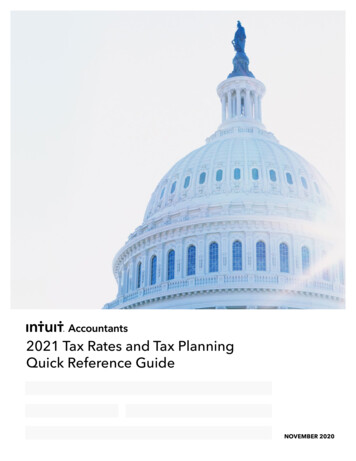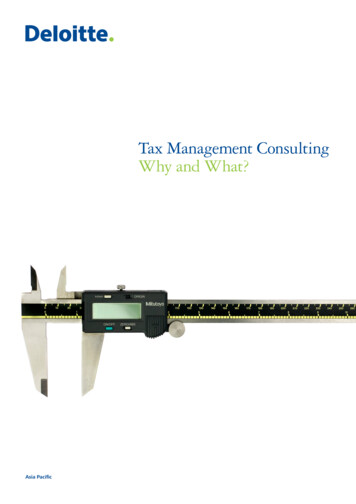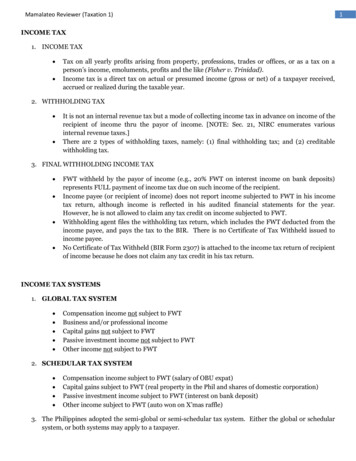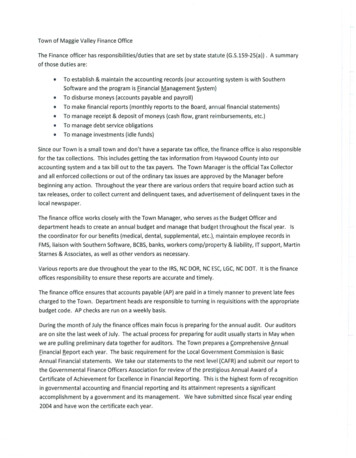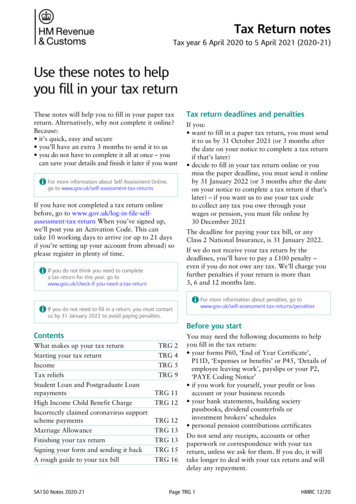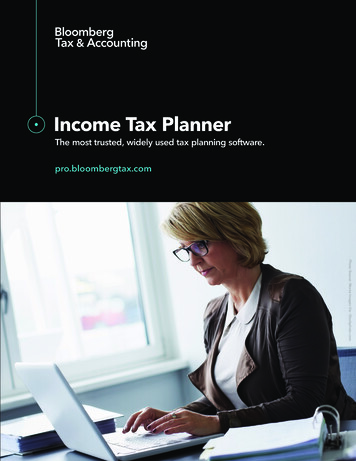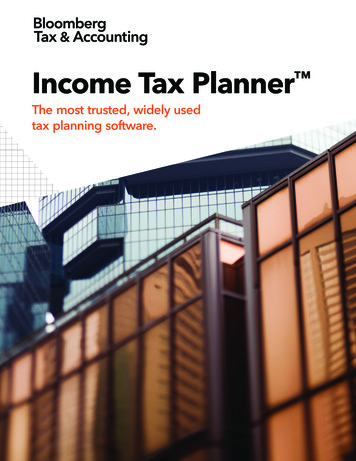
Transcription
Presenting a live 110-minute teleconference with interactive Q&ATax Issues in Sale of Partnership & LLC Interests:Structuring the Purchase AgreementBest Practices for Drafting and Negotiating Tax ProvisionsWEDNESDAY, NOVEMBER 20, 20131pm Eastern 12pm Central 11am Mountain 10am PacificToday’s faculty features:Christopher McLoon, Partner, Verrill Dana, Portland, MaineTimothy J. Leska, Pepper Hamilton, PhiladelphiaChad R. Resner, Senior Manager, KPMG, Washington, D.C.The audio portion of the conference may be accessed via the telephone or by using your computer'sspeakers. Please refer to the instructions emailed to registrants for additional information. If youhave any questions, please contact Customer Service at 1-800-926-7926 ext. 10.
FOR LIVE EVENT ONLYSound QualityIf you are listening via your computer speakers, please note that the qualityof your sound will vary depending on the speed and quality of your internetconnection.If the sound quality is not satisfactory, you may listen via the phone: dial1-866-873-1442 and enter your PIN when prompted. Otherwise, pleasesend us a chat or e-mail sound@straffordpub.com immediately so we can addressthe problem.If you dialed in and have any difficulties during the call, press *0 for assistance.Viewing QualityTo maximize your screen, press the F11 key on your keyboard. To exit full screen,press the F11 key again.
FOR LIVE EVENT ONLYFor CLE credits, please let us know how many people are listening online bycompleting each of the following steps: Close the notification box In the chat box, type (1) your company name and (2) the number ofattendees at your location Click the SEND button beside the boxFor CPE credits, attendees must listen throughout the program, including the Q &A session, and record verification codes in the corresponding spaces found on theCPE form, in order to qualify for full continuing education credits. Strafford isrequired to monitor attendance.If you have not printed out the “CPE Form,” please print it now (see “Handouts”tab in “Conference Materials” box on left-hand side of your computer screen).Please refer to the instructions emailed to registrants for additional information.If you have any questions, please contact Customer Service at 1-800-926-7926ext. 10.
FOR LIVE EVENT ONLYIf you have not printed the conference materials for this program, pleasecomplete the following steps: Click on the symbol next to “Conference Materials” in the middle of the lefthand column on your screen. Click on the tab labeled “Handouts” that appears, and there you will see aPDF of the slides for today's program. Double click on the PDF and a separate page will open. Print the slides by clicking on the printer icon.
Tax Issues in Sale of Partnership& LLC Interests:Structuring the Purchase AgreementTimothy J. LeskaPepper Hamilton, Philadelphialeskat@pepperlaw.comChristopher McLoonVerrill Dana, Portland, Mainecmcloon@verrilldana.com
I. Introduction of Tax implications for buyer and seller A. Tax Classification of Partnerships and LLCs1.2.3. Eligible entities within meaning of 301.7701-3.Mechanics to achieve certain goals differ depending upon classification of target.Also consider pre-closing structure alternatives.B. Seller’s gain or loss1.2.Sale of a partnership interest results in capital gain or loss, except for hot assets. Holdingperiod generally determined by holding period of interest.Character of gain/loss on sale of assets depends upon particular assets being sold; holdingperiod determined by particular assets. 3.4.Purchase price allocation important, and should be included in agreement.Redemption of partnership interests: 5.Remember sale of a disregarded LLC is a sale of assets.736(a) v. 736(b)Differences between purchase across the top and redemption from the partnershipA partnership interest not eligible for 1031 like-kind exchange. Disregarded entities?Same partnership?6
I. Introduction of Tax implications for buyer and seller (cont.) C. Buyer’s basis1. A buyer’s basis is cost, including assumed liabilities.2. Acquisition of assets results in basis in assets.3. Acquisition of partnership interest results in basis in the interest itself; absent 754election (or built-in loss situation), however, the step-up in basis in the partnershipinterest is not matched by a basis step-up in the assets held by the partnership.4. Example: A owns a 40% interest in AB partnership with a value of 4 and a basis of 1.AB owns a single investment property (“X”) with a value of 10 and a basis of 2.50. C acquires A’s interest for 4. C’s basis in 40% interest is 4.Without 754 election, AB’s basis in X remains 2.50. If X subsequently sold for 10 (i.e. no post-C purchaseappreciation), AB recognizes 7.50 of gain, of which 3 is allocated to C. C would receive an offsetting loss onliquidation, but timing issue.With 754 election, AB’s basis in X becomes 5.50. On sale of X for 10, C recognizes no further gain.7
I. Introduction of Tax implications for buyer and seller (cont.) D. Installment reporting for selling partner1. Gain on sale of a partnership interest generally eligible for installment reporting.2. Impact of hot assets.3. Better answer if structured as redemption? E. Income/Loss Allocation issues1. Sections 706(c) and (d) are controlling provisions.2. Each of buyer and seller must be allocated items for the year. Pro rationClose of the books (optional and mandatory)3. Purchase agreement provisions.8
Slide Intentionally Left Blank
II. Structuring the Sale Assets Sales – Partnership level determination– Gain or loss depends on allocation of amountrealized– Character determined with reference to eachasset– Timing Installment Sale– Depends on assets sold– Partner allocations – Section 704(b)10
II. Structuring the Sale Assets Sales – Acquiring Company– Basis credit for assets based on Section 1012– Allocation of purchase price to assets affects costrecovery timing– Intangibles 15 year recovery11
II. Structuring the Sale (cont.)B.Entity Sales1. Defining the Transaction 2.Impact on purchase agreement (general) 3.Basis step-upInput on tax-matters of underlying partnership going forwardImpact on purchase agreement (tax specific) 6.Capital gain v. ordinary income751(a) exchange tablesBuyer concerns 5.Income taxes v. non-income taxesTax return preparation706 allocation issues, including tax distributions.Sell side concerns 4.Sale of interest in a tax partnership v. sale of interest in disregarded entitySale of 100% interests/units v. sale of less than 100%Purchase price allocationTax treatmentElectionsPost-closing risk allocationCompany concerns Impact on tax returns (termination?)Impact on method of account (sec. 448)12
II. Structuring the Sale (cont.)B. Entity Sales (cont.)Example: A is a one-third partner in ABC LLC, a tax partnership. A’s interest has a basis of 3. ABC, a cash method partnership, has three fixed assets: (i) 3 of cash; (ii) A/R with a value of 9 and basis of 0; and (iii) equipment with a value of 9 and basis of 6 ( 3 of depreciationpreviously claimed on equipment). D wishes to purchase A’s interest for 9. Assume purchase price allocated 1 to cash, 3 to a/r, 3 to equipment, and remainder togoodwill.1. Transaction: 2.To A: 3.A is selling an interest in a tax partnership representing less than 100% of the interests in the partnership.As a sale of a partnership interest, sec. 741 provides for capital gain except to the extent of hot assets.A’s gain is 6 ( 9- 3). If ABC sold all of its assets, A would be allocated 3 of income from A/R and 1 of income fromequipment, which would be recapture. Thus, 4 of A’s gain is ordinary. Remaining 2 if capital.To D: 9 of basis in acquired interest. No step-up in ABC assets without 754 election.Will D simply step into shoes of A regarding tax matters?13
II. Structuring the Sale (cont.)B. Entity Sales (cont.)Example (cont.):1. Allocation issues: closing of the books under 706(c)2. Purchase agreement How does D ensure 754 election if desired?Purchase price allocation dictated A’s ordinary income/cap gain mix.Indemnity package—note impact on A’s gain if indemnification obligation arises.3. Company issues Sale of less than 50%--so no termination, but must now track.Does D’s admission cause change in method of accounting?14
II. Structuring the Sale (cont.)B. Entity Sales (cont.)Example Modified: Assume same facts, but instead of D buying directly from A, D contributes 9 to ABC fora preferred interest ( 9 return of capital plus accruing return) and ABC uses 9 toredeem A.1. Transaction: Pursuant to 707(a)(2)(B), A still considered as selling an interest in a tax partnership representing less than100% of the interests in the partnership.2. To A: Same as above.3. To D: Basis results the same as above 9 of basis in acquired interest. No step-up in ABC assets without 754election.Note, however, change in parties to transaction. D is contracting with ABC directly, and, due to nature ofacquired interest, ABC operating agreement will need to be amended. Greater likelihood forcontrol/access/754 election?15
II. Structuring the Sale (cont.) Acquiring all Interests of LLC: Revenue Ruling 99-616
Rev. Rul. 99-6– Gain or loss– Basis in assets– Holding period– Section 704(c) and 737– Terminate partnership17
Rev. Rul. 99-6 – Situation 1ABBABLLC InterestsLLCLLC1. A and B each own 50% of LLC Interests2. A sells all of its LLC Interest to B3. B is the sole Member18
Rev. Rul. 99-6 – Situation 1 – To A– Gain or loss Section 741– Amount realized: includes 752 amounts Section 751(a)– Changes character of gain in share of hot assets» Includes depreciation recapture» Not unrealized recapture gain19
Rev. Rul. 99-6 – Situation 1 – To B– Gain or loss Section 731– Cash, marketable securities– 752 distributions– Section 1239 – sale of depreciable property betweenrelated parties– Section 735(a) – Sale or exchange of distributedunrealized receivables– Basis Section 732(a)– B generally gets carryover basis in distributed property,to the extent of B’s basis in LLC interest Section 1012– Property deemed acquired from A has a cost basis in B’shands20
Rev. Rul. 99-6 – Situation 1 – To B– Holding Period Section 735(b)– Tacking for capital assets and Section 1231 assets– No tacking for inventory, property held for sale inordinary course– Section 704(c)(1)(A) and 737 Gain recognized on property distribution– B’s contributed section 704(c) property deemeddistributed to A– Exchange of other property for B’s contributed Section704(c) property21
Rev. Rul. 99-6 – Situation 1 – To B– Tax Partnership Terminates Elections no longer effective Depreciation periods start over22
Rev. Rul. 99-6 – Situation 2CDCLLC InterestsEEDLLC InterestsLLCLLC1. C and D each own 50% of LLC Interests2. C and D sell all of their LLC Interest to E3. E is the sole Member23
Rev. Rul. 99-6 – Situation 2 – To C and D– Gain or loss Section 741– Amount realized: includes 752 amounts Section 751(a)– Changes character of gain in share of hot assets» Includes depreciation recapture» Not unrealized recapture gain24
Rev. Rul. 99-6 – Situation 2 – To E– Basis Section 1012– Cost of assets– Includes liabilities to which assets are subject– Holding Period Date of “sale”25
II. Structuring the Sale (cont.) Acquiring all Interests of LLC: Interests-Over Merger26
LLC Merger– Types– Gain or loss– Basis– Holding periods– Section 704(c)27
LLC Merger– Types Interests-Over– A and B transfer their AB LLC Interests to CD inexchange for CD LLC Interests– Treated as an “assets-over” merger Assets-Over– AB LLC transfers its assets to CD LLC in exchange forCD LLC Interests, then distributes CD LLC Intereststo A and B in liquidating distribution Assets-Up– AB liquidates; A and B contribute assets to CD LLCfor CD LLC Interests28
Interests Over Merger – State LawAABAAB LLC InterestsCD LLC InterestsBABCBDCDAB LLC InterestsABCD1. A and B transfer AB LLC Interests to CD LLC for CD LLCInterests2. CD becomes ABCD LLC3. AB LLC terminated29
Interests Over Merger – Tax LawAABABAssets/LiabsABCBDCD LLC InterestsCD LLC InterestsCDABABCD1. AB LLC transfers assets and liabilities to CD LLC for CD LLCInterests2. AB LLC liquidates3. AB LLC terminated30
Assets Over – for A and B– Gain AB contributes assets and liabilities in 721transaction– Possible gain from deemed distribution under 752or actual distribution (if any) A and B treated as receiving property inexchange for AB interests in liquidatingtransaction– Should be no gain or loss recognized under Section73131
Assets Over – For A and B– Basis A and B take basis in partnership interestsunder Section 732– Holding Period LLC Interests are capital assets. Holding periodtacking under Section 1223– Section 704(c) New 7 year period begins with contribution toCD32
II. Structuring the Sale (cont.) E. 99-5 Transactions1. Defining the Transaction Where Target is an LLC that is wholly-owned, it is a disregarded entity for tax (absent CTB election).When less than 100% of the LLC units are acquired, the LLC becomes a tax partnership.2. Units acquired from sole owner (asset sale)3. Units acquired from LLC and proceeds remain with LLC (721)4. Units acquired from LLC but proceeds distributed to sole owner (707(a)(2)(B)) Example: A owns 100% of LLC, which has A/R ( 10) and goodwill ( 6). B contributes 8 for a 50% interest. 8immediately distributed to A.B is treated as contributing cash to LLC solely for equity.A is treated as contributing A/R and goodwill to LLC in return for equity and cash. As a result, A deemed tosell 8 of assets and will recognize income/gain.33
II. Structuring the Sale (cont.) E. 99-5 Transactions (cont.)1. S corporation is target Where S corporation is a target, but facet of transaction would preclude S corp treatment going forward,consider restructuring.S corp contributes assets to newly formed LLC, at which level transaction occurs.Rev. Rul. 2008-18 provides alternative if transfer of assets not feasible.2. Example A owns 100% of Target, an S corp. B, a tax partnership, wishes to acquire a 50% stake in the business (or B isan individual but desires preferred equity).A contributes Target to New Holdco (which also qualifies as an S corp), and Target elects to be a Qsub. Targetthen converts into an LLC.B then invests directly into LLC. 99-5 principles apply to investment.3. Sec. 197 planning If B wishes to amortize Target’s goodwill but Target subject to anti-churning, further planning is required.Compare 1.197-2(k) examples 18 and 19.In example above, following LLC drop down, A invests in LLC to make LLC a tax partnership. Timing?34
Slide Intentionally Left Blank
Allocation ofPurchase Price inAsset SaleChad R. ResnerWashington, D.C.cresner@KPMG.com
NoticeANY TAX ADVICE IN THIS COMMUNICATION IS NOT INTENDED ORWRITTEN BY KPMG TO BE USED, AND CANNOT BE USED, BY ACLIENT OR ANY OTHER PERSON OR ENTITY FOR THE PURPOSE OF(i) AVOIDING PENALTIES THAT MAY BE IMPOSED ON ANY TAXPAYEROR (ii) PROMOTING, MARKETING OR RECOMMENDING TO ANOTHERPARTY ANY MATTERS ADDRESSED HEREIN.You (and your employees, representatives, or agents) may disclose to any and allpersons, without limitation, the tax treatment or tax structure, or both, of anytransaction described in the associated materials we provide to you, including, but notlimited to, any tax opinions, memoranda, or other tax analyses contained in thosematerials.The information contained herein is of a general nature and based on authorities thatare subject to change. Applicability of the information to specific situations should bedetermined through consultation with your tax adviser. 2013 KPMG LLP, a Delaware limited liability partnership and the U.S. member firm of the KPMG network of independentmember firms affiliated with KPMG International Cooperative (“KPMG International”), a Swiss entity. All rights reserved.37
III. Allocation Of PurchasePrice In An Asset Sale
Character – Asset Sale Gain or loss from the sale of assets–Difference between the amount realized and the adjusted basis of theproperty sold. Section 1001(a). Character–Capital gain or loss from sale of capital assets–Ordinary income or loss from noncapital assets–Net gain taxed as capital gain and net loss treated as ordinary loss fromthe sale of section 1231 assets Gain or loss allocated under the partnership agreement–If the partnership sells assets the gain or loss is recognized by the partnership.–Allocation of gain or loss by partnership must satisfy section 704(b). 2013 KPMG LLP, a Delaware limited liability partnership and the U.S. member firm of the KPMG network of independentmember firms affiliated with KPMG International Cooperative (“KPMG International”), a Swiss entity. All rights reserved.39
Character – Asset Sale – Valuation of Assets Section 1060– Provides rules for determining transferee’s basis and transferor’s gainor loss when there is an applicable asset acquisition.– Applicable asset acquisition is any transfer –Of assets constituting a trade or business, Where the transferee’s basis is determined wholly by reference to the considerationpaid for such assets. –Consideration must be allocated among the assets in the same manneras under section 338(b)(5). Allocation of consideration– Allocated under the residual method under regulations 1.338-6 and1.338-7.– Seven classes of assets used in the residual method. When should section 1060 type considerations be applied tovaluing assets? 2013 KPMG LLP, a Delaware limited liability partnership and the U.S. member firm of the KPMG network of independentmember firms affiliated with KPMG International Cooperative (“KPMG International”), a Swiss entity. All rights reserved.40
Sale of Partnership Interest – Character – Section 751(a) Section 741 – Generally considered gain or loss from the sale of acapital asset. Section 751(a) (exception) – The amount of any money, or the fairmarket value of any property, received by a transferor partner inexchange for all or a part of his/her interest in the partnershipattributable to unrealized receivables or inventory items of thepartnership shall be considered as an amount realized from the saleor exchange of property other than a capital asset.–For sales and exchanges of interests, “inventory” includes all inventory items,not only “substantially appreciated” inventory items as in the case ofdisproportionate distributions subject to section 751(b)–Unrealized receivables and inventory items, as described in section 751, arealso known as “hot assets” 2013 KPMG LLP, a Delaware limited liability partnership and the U.S. member firm of the KPMG network of independentmember firms affiliated with KPMG International Cooperative (“KPMG International”), a Swiss entity. All rights reserved.41
Character – Section 751(a)Amount subject to section 751(a)Net amount of income or loss from section 751 property that would have beenallocated to the transferor partner (to the extent attributable to the interest sold orexchanged) if the partnership had sold all of its property in a fully taxabletransaction for cash in an amount equal to the FMV of such property (section1.751-1(a)(2)).Amount subject to section 751(a) is ordinary income or lossand the remaining amount of “gain or loss” is capitalPreliminary Capital Gain or LossLess Section 751(a) Ordinary Income or LossEquals Actual Capital Gain or Loss 2013 KPMG LLP, a Delaware limited liability partnership and the U.S. member firm of the KPMG network of independentmember firms affiliated with KPMG International Cooperative (“KPMG International”), a Swiss entity. All rights reserved.42
Applicable Capital Gains Rate Aggregate theory applies to sale of partnershipinterest.– Look through partnership to underlying assets. Maximum rates for LTCG:– 28% rate for collectibles gain.– 25% rate for unrecaptured sec. 1250 gain.– 20% rate for balance. 2013 KPMG LLP, a Delaware limited liability partnership and the U.S. member firm of the KPMG network of independentmember firms affiliated with KPMG International Cooperative (“KPMG International”), a Swiss entity. All rights reserved.43
Applicable Capital Gains Rate Partnership collectibles and section 1250property:– Selling partner recognizes gain as if the partnershipsold all of its collectibles and section 1250 propertyin a fully taxable transaction immediately before hesold his interest.– Does not apply to redemptions.– Look through rule for tiered partnerships. 2013 KPMG LLP, a Delaware limited liability partnership and the U.S. member firm of the KPMG network of independentmember firms affiliated with KPMG International Cooperative (“KPMG International”), a Swiss entity. All rights reserved.44
Applicable Capital Gains RateAmount realizedLess(Adjusted basis) Total gain or lossLess(Ordinary income (section 751(a)))Less(STCG or STCL) “Pre-Look-Thru” LTCG or LTCLLess(Collectibles gain)Less(Unrecaptured section 1250 gain) Residual LTCG or LTCL 2013 KPMG LLP, a Delaware limited liability partnership and the U.S. member firm of the KPMG network of independentmember firms affiliated with KPMG International Cooperative (“KPMG International”), a Swiss entity. All rights reserved.45
Summary Example A and B are equal partners in a partnership witheach having contributed cash to the partnershipin formation. After holding his interest for more than one year,A sells his entire interest in the partnership to Cfor 10,000. The partnership has the following balancesheet: 2013 KPMG LLP, a Delaware limited liability partnership and the U.S. member firm of the KPMG network of independentmember firms affiliated with KPMG International Cooperative (“KPMG International”), a Swiss entity. All rights reserved.46
Summary ExampleTax BasisFMVA’s Share ofGain (Loss)1,0002,000500Unrealized receivables014,0007,000Section 1250 property*(original cost 1,000)01,000500Other capital assets6,0003,000(1,500)Total Assets7,00020,0006,500Capital: A3,50010,0006,500Capital: B3,50010,000Total Liabilities/Capital7,00020,000AssetsCollectibles 2013 KPMG LLP, a Delaware limited liability partnership and the U.S. member firm of the KPMG network of independentmember firms affiliated with KPMG International Cooperative (“KPMG International”), a Swiss entity. All rights reserved.6,50047
Summary ExampleAmount realized10,000(Adjusted basis)(3,500)Total gain or loss6,500(Ordinary income (section 751(a)))(STCG or STCL)(7,000)7,000(0)“Pre-Look-Thru” LTCG or (LTCL)(500)(Collectibles gain)(500)500(Unrecaptured section 1250 gain)(500)500Residual LTCG or (LTCL)(1,500)(1,500)6,500 2013 KPMG LLP, a Delaware limited liability partnership and the U.S. member firm of the KPMG network of independentmember firms affiliated with KPMG International Cooperative (“KPMG International”), a Swiss entity. All rights reserved.48
Slide Intentionally Left Blank
Section 751(a) – Reporting Requirements A partnership must file Form 8308, Report of a Sale or Exchange ofCertain Partnership Interests–Generally attach to Form 1065 unless the partnership receives notice oftransfer subsequent to the filing of Form 1065 The transferor partner in a partnership holding section 751 propertymust attach a statement to its tax return reporting ––The date of the sale or exchange;–The amount of gain or loss attributable to section 751 property; and–The amount of any gain or loss attributable to capital gain or loss 2013 KPMG LLP, a Delaware limited liability partnership and the U.S. member firm of the KPMG network of independentmember firms affiliated with KPMG International Cooperative (“KPMG International”), a Swiss entity. All rights reserved.50
Impact on Selling Partner – Recap Amount of gain or loss– Liabilities relieved included in amount realized– Adjusted tax basis includes seller’s distributiveshare of income or loss through the date of sale– Section 706 Character of gain or loss:– Capital, unless section 751 applies. Holding period may be bifurcated:– Part short-term / Part long-term. Different capital gains rates may apply. 2013 KPMG LLP, a Delaware limited liability partnership and the U.S. member firm of the KPMG network of independentmember firms affiliated with KPMG International Cooperative (“KPMG International”), a Swiss entity. All rights reserved.51
Impact on Buying Partner Basis in acquired interest equals:– Cost (cash FMV of property);– Plus share of liabilities assumed. Consider basis adjustments. Termination of the partnership.– Actual termination: Buying partner owns 100% ofpartnership. Section 708(b)(1)(A).– Technical termination: 50% or more of the capital andprofits interests are transferred within a 12-month period.Section 708(b)(1)(B). Impact on partnership’s tax year? 2013 KPMG LLP, a Delaware limited liability partnership and the U.S. member firm of the KPMG network of independentmember firms affiliated with KPMG International Cooperative (“KPMG International”), a Swiss entity. All rights reserved.52
Purpose of Section 743(b) Adjustments Protects purchasing partner from gain or lossinherent in the partnership interest. Treats partner as if he purchased an interest ineach partnership asset. Affects transferee partner only. 2013 KPMG LLP, a Delaware limited liability partnership and the U.S. member firm of the KPMG network of independentmember firms affiliated with KPMG International Cooperative (“KPMG International”), a Swiss entity. All rights reserved.53
Effect of Section 743(b) Adjustments Sale of adjusted property:– Sec. 743(b) adjustment does not affect gain recognized bythe partnership on sale of its assets.– Adjustment affects gain recognized by the transfereepartner only. Three basic steps:1. Compute partnership’s gain or loss from sale ofproperty.2. Allocate gain or loss to the partners under sec. 704(b)and 704(c).3. Adjust transferee partner’s share of gain or loss for sec.743(b) adjustments on the property. 2013 KPMG LLP, a Delaware limited liability partnership and the U.S. member firm of the KPMG network of independentmember firms affiliated with KPMG International Cooperative (“KPMG International”), a Swiss entity. All rights reserved.54
Effect of Section 743(b) Adjustments Adjustments to depreciable property:– Positive Adjustments: Treated as a newly placed in service asset. Creates additional depreciation for the transferee partner. Special rule for remedial allocation method.– Negative Adjustments: Recoveredover remaining useful life of property. Reduces the transferee partner’s depreciation allocation. May trigger ordinary income. 2013 KPMG LLP, a Delaware limited liability partnership and the U.S. member firm of the KPMG network of independentmember firms affiliated with KPMG International Cooperative (“KPMG International”), a Swiss entity. All rights reserved.55
Reporting Requirements The transferee partner that acquires interest in PRS that has section754 election in effect must notify PRS of transfer within 30 days.1. Include names, addresses, and tax identification number oftransferee and transferor (if known)2. Date of transfer3. Relationship, if any, of transferee and transferor4. Other information necessary so that the partnership can calculatetransferee’s basis in its acquired interest (e.g., purchase price andliabilities assumed) PRS must include statement with return for taxable year that itacquires knowledge of transfer.–Identify transferee, show basis adjustment, and the allocation of theadjustment. 2013 KPMG LLP, a Delaware limited liability partnership and the U.S. member firm of the KPMG network of independentmember firms affiliated with KPMG International Cooperative (“KPMG International”), a Swiss entity. All rights reserved.56
Impact on Buying Partner – Recap Basis in the partnership interest acquired– Cost basis (assuming taxable purchase)– Share of partnership debt Section 754 election– Already in effect or should the partnership make one?– Mandatory adjustment? Section 706 method Section 704(c)– Step-in-the-shoes– Section 704(c)(1)(C) exception 2013 KPMG LLP, a Delaware limited liability partnership and the U.S. member firm of the KPMG network of independentmember firms affiliated with KPMG International Cooperative (“KPMG International”), a Swiss entity. All rights reserved.57
Nov 20, 2013 · II. Structuring the Sale (cont.) B. Entity Sales (cont.) Example (cont.): 1. Allocation issues: closing of the books under 706(c) 2. Purchase agreement How does D ensu



